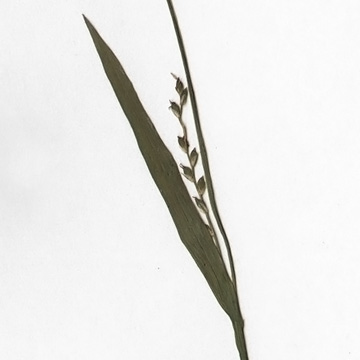

Carex laxiflora - (image 1 of 2)
Taxonomy
Family: Cyperaceae
Section Laxiflorae
Habitat
Dry to mesic woods.
Associates
Distribution
ME and southern Quebec to DE and MD and in mountains to NC, TN, and AL, west to WI and IN.
Morphology
Tufted perennial; culms 30-50 cm, erect or ascending, lateral or sometimes central, sharply triangular and narrowly winged, smooth or nearly so; basal sheaths light brown; leaves of short sterile shoots 5-25 mm wide, those of the fertile shoots narrower, 2-8 mm; terminal spike staminate, 1-2.5 cm, on a peduncle 1-2 cm; pistillate spikes 2-4, slender, 1-3 cm long, scattered on short or elongate, erect peduncles, none basal; at least the lower pistillate scales cuspidate or short-awned; perigynia 5-15, only slightly or scarcely overlapping, 2.6-3.8 mm, 2-ribbed and finely many-nerved, obstusely trigonous, obovoid, tapering to a rather short, straight or slightly outcurved beak with an oblique, entire opening; achene trigonous.
Notes
Fruiting April to June
Wetland indicator: UPL
Carex striatula is similar but with larger perigynia (3.4-5 mm long) that taper evenly at both ends; the perigynia of C. laxiflora taper more gradually at the base than to the beak at the apex.
References
Ball, P.W. and A.A. Reznicek. 2002. Carex, In: Flora of North America Editorial Committee, Eds. Flora of North America North of Mexico. Volume 23. Oxford University Press, New York.
Gleason, Henry A. and A. Cronquist. 1991. Manual of Vascular Plants of
Northeastern United States and Adjacent Canada. Second Ed.
The New York Botanical Garden. Bronx, NY
|
© Michael Hough 2018 |